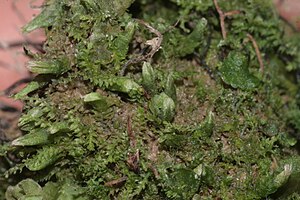Cephalozia bicuspidata
| Cephalozia bicuspidata | ||||||||||||
|---|---|---|---|---|---|---|---|---|---|---|---|---|

Cephalozia bicuspidata |
||||||||||||
| Systematics | ||||||||||||
|
||||||||||||
| Scientific name | ||||||||||||
| Cephalozia bicuspidata | ||||||||||||
| ( L. ) Dumort. |
Cephalozia bicuspidata , German name also Zweispitziges Kopfsproßmoos , is a liverwort species from the family Cephaloziaceae .
features
Cephalozia bicuspidata forms dense, green to reddish-brown lawns. The prostrate, branched plants are up to 2 centimeters long, their branches are about 1 millimeter wide. Stolons and flagella-like shoots are often present. The flank leaves are about 12 to 14 cells wide, on the stem obliquely to almost transversely and not growing downward, hollow to spherical and up to a third or half of their length divided into two lanceolate, sharply pointed lobes; these are straight protruding or only slightly bent towards each other. The tips of the leaf lobes end with one to three single row cells. Lamina cells are 20 to 45 µm by 33 to 70 µm in size at the base of the leaf lobes and usually do not contain any oil bodies .
The moss species is monoecious . Perianthia are often present, they are up to 3 millimeters long, oblong-cylindrical, far downwards, bluntly triangular, with a short serrated mouth. The female bracts are larger than the flank leaves, in two parts, rarely in three parts, with mostly serrated edges. Spores are 14 to 18 µm in size, red-brown and papilose. Depending on the altitude, spores ripen from spring to summer. Occasionally oval or spherical brood bodies are formed.
variability
Cephalozia bicuspidata is a diverse species. It is also divided into two infraspecific taxa:
- var. bicuspidata and
- var. lammersiana (Huebener) Breidl.,
which, however, cannot be clearly separated morphologically.
Occurrence
The moss grows in fresh to wet locations in forests, on embankments and roadsides. It prefers to colonize lime-free soil, less often lime-free rocks or rotten wood. Frequent accompanying mosses are Atrichum undulatum , Dicranella heteromalla , Diplophyllum albicans , Polytrichum formosum , Scapania nemorea and Calypogeia species.
distribution
The species is widespread in the northern hemisphere in the temperate to arctic zones and is common here from the plains to high alpine regions. In the southern hemisphere there are occurrences in South America, South Africa and tropical Africa, Australia, New Zealand.
literature
- Jan-Peter Frahm, Wolfgang Frey, J. Döring: Moosflora . 4th edition, UTB Verlag, 2004, ISBN 3-8252-1250-5
- Nebel, Philippi: Die Moose Baden-Württemberg Volume 3 . 1st edition, Ulmer Verlag, 2005, ISBN 3-8001-3278-8
- Ruprecht Düll, Barbara Düll-Wunder: Determine mosses easily and reliably . Quelle & Meyer Verlag Wiebelsheim, 2008, ISBN 978-3-494-01427-2